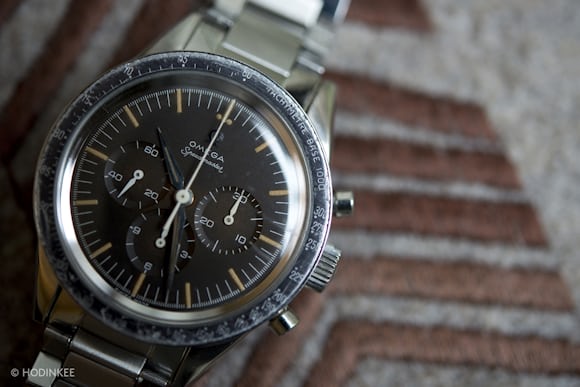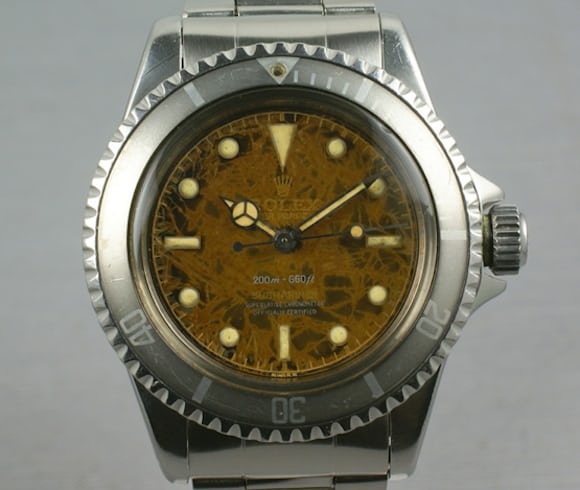In 1993, a Daytona 6239 "Paul Newman" hammered at Antiquorum for $9,257. In 2013, the same reference hammered for $75,000 at Christie's, and since then prices have continued to rise. This may be a challenging year for newer watches (pre-owned or new) but the most desirable vintage models, especially those in good original condition, are still – to all appearances – blue chip buys and investment opportunities. And yet, much, or even most, of the value of some very collectible watches rests on something that was never intended to last forever, and which may well deteriorate out of all recognition in the lifetime of its owner: the dial.
Aging of a watch dial and dial markers can take on an almost infinite variety of forms, including browning ("tropical" dials) crazing ("spiderweb" dials) and other forms of aging seen as dramatically enhancing the value of a watch. Such aging might seem simply a sign of a watch past its prime to the uninitiated, but to serious enthusiasts and collectors, a dial that has aged properly – emphasis on properly – is an indication of a certain honestly and authenticity by which modern collectors set high store.
Despite this, the whole idea that a visibly aged dial should command a premium seems a fairly new one, and perhaps no where can this be seen more clearly than in how brand service centers respond to requests to leave certain parts untouched. Collectors often struggle to get brand service centers to leave original (or presumed original) dials on a watch. Service centers, on the other hand, are very often still driven by service policies that originated in an era when a watch with a noticeably cosmetically compromised (and often functionally compromised) dial was the last thing most consumers wanted. A dial with badly faded paint, yellowed lacquer, and luminous markers that no longer glowed was simply seen as well past its useful lifespan. Brand service centers were not (and generally, still are not) in the conservation business; their brief was to return the watch to the client in, as much as possible, new condition, both functionally and cosmetically.

Aged dials are nowadays seen by collectors as evidence of authenticity and as a visible connection to the history of a watch. Our relationship to dial patina can be a complicated one. In art, there's a similar conundrum: when restoring an artwork, should you try to bring it back to, as much as possible, as-new condition, or should you simply act to make sure there's no progressive deterioration going on? One dramatic example of how opinions can differ is the restoration of one of Leonardo da Vinci's most famous oil paintings: the Virgin And Child With St. Anne. The restoration was undertaken at the Louvre in 2011, and the change in the painting was dramatic. The soft browns, umbers, and burnt sienna tones many associated with the painting vanished under the restorer's cleaning swab, revealing bright blues, reds, and skin tones no one had suspected lurked under centuries of accumulated grime and surface oxidation. The outcry at the transformation bears a noticeable similarity to the anger many collectors express at an unasked-for change in a beloved watch – and it's not just sentimental attachment; in today's market the substitution of a new for an original dial can utterly demolish the value of a timepiece.

And yet, like artworks, dials are made of materials that slowly but irrevocably change over time. One of the very surprising things about watch dials is just how little good, reliable information there really is out there, about how chemically stable the materials are that were originally used to make watch dials. In general, though, paints and lacquers have a limited life expectancy; oxidation, heat, ultraviolet radiation, and moisture can all exert slow but inexorable, and largely irreversible, effects on watch dials. This may not have mattered much when a Paul Newman Daytona was a sub ten thousand dollar watch but today, with hundreds of thousands of dollars (or even millions) riding on subtleties of dial cosmetics, in what are watches whose dials were never intended to last indefinitely, the question becomes a worrying one. Lume plots will, sooner or later, detach themselves from dials; "tropical" dials may very well continue to fade, discolor, or otherwise behave in unpredictable ways, and no one can really say with any certainty what will happen over the next few decades to dials of extremely high value watches that were bought with the largely unspoken assumption that the condition they're in now, is the condition they'll retain in the future.

Have vintage watches been a good investment over the last ten years? In at least some cases they have been an absolutely spectacular investment with rates of return unheard of in most other investment vehicles. But there may be a perfect storm just over the horizon: a softening of the vintage watch market, combined with the huge number of possible and probable fakes that have entered the market, combined with the irreversible physical deterioration many watches may exhibit, could easily combine to make vintage watch collecting a very dangerous sea on which to sale.
No comments:
Post a Comment